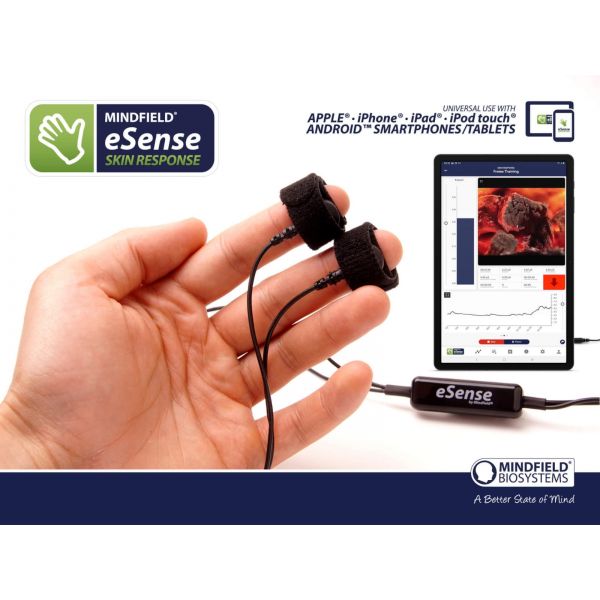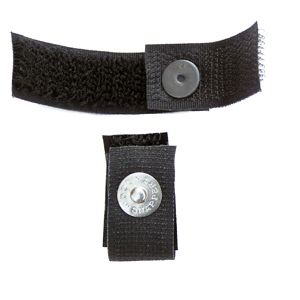We use cookies to make your experience better. To comply with the new e-Privacy directive, we need to ask for your consent to set the cookies. Learn more.
Mindfield eSense Skin Response - GSR sensor for iPhone & Android
- Measure and reduce stress with biofeedback
- Easy and fun to use
- Track progress over time
- Export your session data
In Stock
The Mindfield eSense Skin Response is a small sensor to measure your skin conductance using the microphone input of your smartphone or tablet (Android or Apple iOS).
The Mindfield eSense Skin Response is a small sensor to measure your skin conductance using the microphone input of your smartphone or tablet (Android or Apple iOS).
Your skin conductance depends directly on your state of relaxation or stress, making it a commonly used and very precise stress indicator. With the eSense Skin Response, you can precisely identify your stress level, from home with just your smartphone or tablet.
The eSense provides you in various ways with exact feedback about your momentary stress level, e.g. with measurement curves, video display and audio feedback features.
With all those functions, you can use the eSense in combination with the app to:
- create and practice given or your own biofeedback training
- create and use a guide for meditation
- measure and reduce your stress level
For audio biofeedback, the eSense Skin Response has a headphone jack, so you can additionaly listen to music or audio books while training your stress level down. eSense Skin Response also supports biofeedback via smart bulbs. Smart bulbs can change their colors and brightness and can be controlled via Bluetooth. Currently the eSense app supports the Magic Blue™ and Philips Hue™ products.
The app for eSense is free and you can export the measured data as a CSV-file.
Get the Mindfield eSense App
How to Use eSense Skin Response
Skin response, also known as galvanic skin response (GSR), electrodermal response (EDR) or skin conductance (SC) is a measurement method based on bio-electrical properties of the skin. The skin conductance depends on the activity of the sweat glands of the skin and reacts to the smallest changes, which we can’t detect as wet hands yet. The eSense Skin Response applies a very small, safe and unnoticeable electrical voltage, which results in an electrical current to the skin. Through the changes of this small current, we can measure the activity of the perspiration glands of the skin far below the threshold of self-perception. The higher the activity of the sweat glands, the more the skin gets wet and the better the current is conducted. As a result, the Skin Conductance rises.
The Skin Response measures the Skin Conductance in Micro Siemens or µSiemens. Skin conductance is measured in µSiemens or symbolized as µS (where µ denotes a millionth and Siemens is the unit of conductance). “Skin resistance” is also a common term, simply denoting the inverse of conductance (1S = 1/Ω).
The activity of the perspiration glands is determined by the autonomic nervous system, which contains two major subunits: the parasympathetic nervous system and the sympathetic nervous system. The perspiration glands of the skin are solely controlled by the sympathetic nervous system, making them a good indicator for inner strain and stress. The sympathetic nervous system reacts to stress stimuli by activating all the “emergency functions” of the body, bringing it to a state of heightened responsiveness: Pulse and blood pressure rise along with the glucose level in the blood and general alertness. With these changes comes the effect of “wet hands” on which our measurement relies.
We all know a time in our lives when we got wet hands. Think of the speech you gave in front of an audience, or a job interview. If in those situations you were excited, can you remember the cold, sweaty hands?
A scientific theory for this effect assumes that our ancestors needed wet hands to have a firmer grip on things; for example, in an escape or pursuit through difficult terrain. When the threatening situation is over, the parasympathetic nervous system becomes dominant: Pulse, blood pressure and glucose level fall again. The body enters a rest state to allow recuperation. The hands become dry again. The increased activity of the perspiration glands through a (stress) stimulus is easily visible through the associated increase in skin conductance. The stimulus can be mental or emotional strain, or taking a sudden, deep breath, or a startling action like someone unexpectedly clapping hands or the loud drop of an item onto the floor. Just try it with the eSense - you will easily see the effects!
Stress and its vegetative symptoms can be greatly reduced through biofeedback training, where you intentionally work on lowering your skin response. Skin response is a universal tool for biofeedback training. It is widely used in the therapy of anxiety, panic disorders and specific phobias. Further fields of use are high blood pressure, tinnitus and sleep disorders. If you suffer from a serious disorder or medical condition, always consult a professional physician or therapist, and do not attempt to treat yourself. The eSense Skin Response is not a medical device and may only be used for stress reduction training.
Manuals and Data Sheets
eSense Skin Response User Manual
eSense Skin Response Guide to Electrode Positions
Using Smart Bulbs with eSense FAQ (Magic Blue Bluetooth bulb and Philips™ Hue™ products)
Warranty
1 Year manufacturer warranty.





